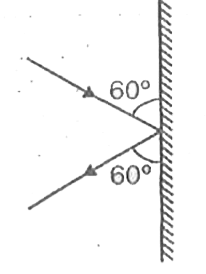A body of mass 0.25 kg moving with velocity 12m/s is stopped by applying a force of 0.6 N. Calculate the time taken to stop the body. Also calculate the impulse of this force.
To solve the problem, we will follow these steps:
Step 1: Calculate the Initial Momentum
The initial momentum P of the body can be calculated using the formula:
P=m⋅v
where:
- m=0.25kg (mass of the body)
- v=12m/s (initial velocity)
Substituting the values:
P=0.25kg×12m/s=3kg m/s
Step 2: Calculate the Final Momentum
Since the body is stopped, the final velocity is 0m/s. Therefore, the final momentum Pf is:
Pf=m⋅vf=0.25kg×0m/s=0kg m/s
Step 3: Calculate the Change in Momentum
The change in momentum ΔP is given by:
ΔP=Pf−P=0−3=−3kg m/s
Step 4: Relate Force to Change in Momentum
The force F applied is related to the change in momentum and the time taken Δt by the equation:
F=ΔPΔt
Given that the force F=0.6N, we can rearrange this equation to solve for Δt:
Δt=ΔPF
Step 5: Substitute Values to Find Time Taken
Substituting the values we have:
Δt=−3kg m/s0.6N=−30.6=−5s
Since time cannot be negative, we take the absolute value:
Δt=5s
Step 6: Calculate the Impulse
Impulse J is defined as the change in momentum, which we already calculated:
J=ΔP=−3kg m/s
Taking the magnitude, the impulse is:
J=3kg m/s
Final Answers
- Time taken to stop the body: 5s
- Impulse of the force: 3kg m/s
The initial momentum P of the body can be calculated using the formula:
P=m⋅v
where:
- m=0.25kg (mass of the body)
- v=12m/s (initial velocity)
P=0.25kg×12m/s=3kg m/s
Since the body is stopped, the final velocity is 0m/s. Therefore, the final momentum Pf is:
Pf=m⋅vf=0.25kg×0m/s=0kg m/s
The change in momentum ΔP is given by:
ΔP=Pf−P=0−3=−3kg m/s
The force F applied is related to the change in momentum and the time taken Δt by the equation:
F=ΔPΔt
Given that the force F=0.6N, we can rearrange this equation to solve for Δt:
Δt=ΔPF
Substituting the values we have:
Δt=−3kg m/s0.6N=−30.6=−5s
Since time cannot be negative, we take the absolute value:
Δt=5s
Impulse J is defined as the change in momentum, which we already calculated:
J=ΔP=−3kg m/s
Taking the magnitude, the impulse is:
J=3kg m/s
- Time taken to stop the body: 5s
- Impulse of the force: 3kg m/s
Topper's Solved these Questions
Similar Questions
Knowledge Check
A body of mass 14kg moving with velocity 12m/s is stopped by applying a force of 0.6 N. Then impulse is :-
A7.2 NsB3 NsC2.4 NsDNoneA ball of mass 0.2 kg moves with a velocity of 20m/sec and it stops in 0.1 sec , then the force on the ball is
A40 NB20 NC4 ND2 NA body moving with uniform velocity is stopped in 0.25 second by applying a retarding force of 200 Newton. The intial momentum of the body will be :-
A50 N-sB100 N-sC150 N-sDZero
A car of mass 2400 kg moving with a velocity of 20 m s−1 is stopped in 10 seconds on applying brakes Calculate the retardation and the retarding force.
View SolutionA body of mass 5 kg is moving with a velocity of 10 m/s. A force is applied to it so that in 25 seconds, it attains a velocity of 35 m/s. Calculate the value of the force applied.
View Solution0A body of mass 20 kg moving with a velocity of 3 m/s, rebounds on a wall with same velocity. The impulse on the body is -
View SolutionA cricket ball of mass 0.2 kg moves with a velocity of 20 m/s and is brought to rest by a player in 0.1 s. Calculate the impulse of the ball and average force applied by the player.
View SolutionA body of mass 3 kg moving with velocity 10 m/s hits a wall at an angle of 60∘ and returns at the same angle. The impact time was 0.2 s. Calculate the force exerted on the wall.

View Solution
